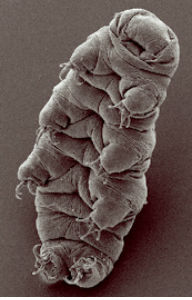Tardigrades
"Waterbears"
|
|
 Waterbear (Hypsibius) Image: B. Goldstein
Waterbear (Hypsibius) Image: B. GoldsteinA tardigrade, or "waterbear," is a microorganism of the phylum Tardigrada. Waterbears have four pairs of legs and live in water, most often in lichens and mosses. Adults range in size from 1.5 mm to below 0.1 mm. The cuticle is chitinous and is regularly molted. The tubular mouth of a waterbear is armed with stylets used to pierce the tissues of other organisms and obtain the fluids on which it feeds. In many ways, they are scaled-down versions of arthropods (or one might say, arthropods are up-scaled versions of waterbears.
 Image: DBCLS
Image: DBCLS
They are famed for their ability to survive in harsh environments by entering an anabiotic condition known as cryptobiosis, or the "tun state." A tun is the drum-shaped, shrunken form that a waterbear takes on when it enters this state. As a waterbear becomes a tun, it secretes the non-reducing sugar trehalose, which protects its membranes, its water content decreases to one percent of normal, and its metabolism drops to less than one ten-thousandth the normal rate.
After being experimentally dessicated for a decade or more, waterbears have been re-hydrated and showed no ill effects. They can tolerate 1,000 times as much ionizing radiation (gamma rays and heavy ions) as a human being. They have also survived boiling, deep freezing to temperatures as low as 1° Kelvin, and exposure to a vacuum. With these characteristics, they are often cited as organisms that could plausibly colonize new planets by surviving the adverse conditions of outer space.